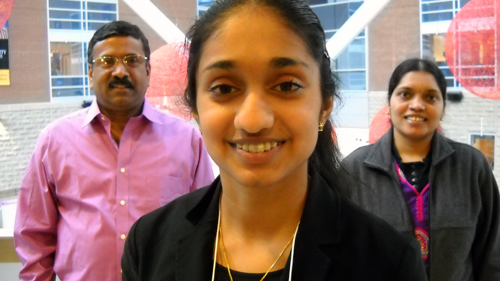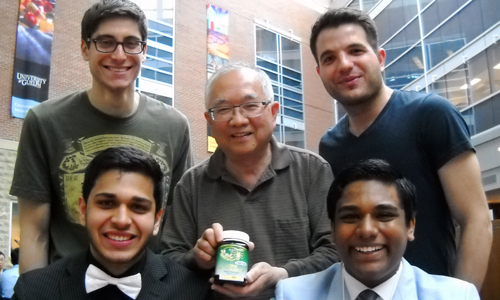
Maybe their next projects should look for the “science gene.”
In a regional science fair competition held on campus this month, two high school students with U of G professors as dads won first and second place with separate projects on using novel foods to fight bacterial infections.
Varsha Jayasankar, a Grade 12 student from St. Catharines, Ont., won top prize in this year’s regional Sanofi BioGENEius Challenge Canada (SBCC) with studies of an antimicrobial agent in mango ginger. Her father, Prof. Jay Subramanian, Plant Agriculture, works on tree fruit breeding in Vineland, Ont.
Second place went to a project on antibacterial properties of manuka honey done by Isaac Thevathasan and Amit Bhattacharyya, both Grade 11 students at Centennial CVI in Guelph.
Speaking of his son, Naresh Thevathasan, manager of agroforestry research and development and an adjunct professor in the School of Environmental Sciences, says, “I’m very proud of him. He wants to enter the University of Guelph in biomedical engineering.”
The regional competition held May 1 in the Science Complex atrium brought together 15 projects from teens across southwestern Ontario. The SBCC is a national research competition intended to encourage high school students to pursue studies and careers in biotechnology. Sponsors include industry, academia and both federal and provincial research granting agencies. U of G’s College of Biological Science hosted this year’s Southwestern Ontario competition.
Visiting Guelph several times a week this year, Jayasankar used chemical techniques to identify an antibacterial compound in mango ginger. Common in South Asia, the spice is also called white turmeric.
Her project began three years ago with homegrown roots.
“It started as a bet with my grandpa. He puts mango ginger in everything.”
When she told him she didn’t like the taste, he told her it was good for her.
Smiling, she says, “It started as ‘I’m going to prove you wrong,’ and he ended up being right. But I got a science fair project out of it, so I’m cool.”
She started looking at the topic with her science fair entry in 2012. At first she worked in Subramanian’s lab in Vineland.
This year, her project turned into a chemistry question — not her father’s forte. “I don’t even know this compound,” says Subramanian, who visited Guelph during the judging.
Jayasankar worked with post-doc Ajila Chandra in the Guelph lab of food science professor Gopi Paliyath. There, she tested components of the spice extract against bacteria.
She also called on other U of G scientists – notably Prof. Emma Allen-Vercoe, Molecular and Cellular Biology, and pathobiology professor Scott Weese — for help with pathogenic strains of bugs such as C. diff.
She says her project is the first to identify the active antimicrobial compound in mango ginger.
Her father has filed an invention disclosure based on her work — the first step toward patent protection — with U of G’s Catalyst Centre. He plans to work with Paliyath and Chandra to refine the compound and learn more about it.
He has mentored Niagara region students to national and international science fairs and exhibitions for eight years. “It feels a little special to see your own kid doing that,” he says, allowing that “she gets more yelling and screaming from me. With others, I have to be more polite and diplomatic.”
Subramanian’s wife, Siva Sikamani, earned a master’s degree in horticulture and was a researcher at the University of Florida.
“I lived in a house that loves science,” says Varsha, who was named in April by Maclean’s magazine as one of Canada’s top 12 future leaders. “Parental support obviously makes a big difference.”
She says she doesn’t think about medals or awards. “I like science, having fun, learning new things.”
Later this month, she will take her project to Ottawa for the national competition and to Los Angeles for the Intel International Science and Engineering Fair.

A homegrown connection to another natural health product also sparked this year’s research for Isaac Thevathasan and Amit Bhattacharyya at CCVI.
Thevathasan’s mom had returned from a family visit to New Zealand with a jar of manuka honey, said to have antibacterial properties.
The students tested the honey along with conventional antibiotics for treating Staphylococcus aureus, which causes skin rash and boils. More worrisome are strains that have developed resistance to antibiotics – notably methicillin — and pose health threats to patients in hospitals and nursing homes.
“It’s a huge issue in hospitals, so we want to see if we can solve it,” says Thevathasan. He was also interested as his mother works as a pediatrician in Guelph. Many common antibiotics cannot be prescribed to very young children.
They found various concentrations of the honey along with varying amounts of antibiotic were effective in killing the bacteria in lab dishes.
Bhattacharyya says using more honey to treat topical infections would be more cost-effective than antibiotics alone. Methicillin costs about $1,500 a gram, compared to honey, which costs pennies per gram – even for imported manuka honey that costs about $100 per jar in a Toronto health food store.
They spent every day since March in the lab of Prof. Joe Lam, Molecular and Cellular Biology. Master’s student David Prevedel says, “They had a real keen interest. Some things they knew were beyond what we expected.”
Thevathasan says Lam obtained specific strains of bacteria from a Texas colleague for the students to test. “Without him, this project would not exist at all.”
Isaac’s sister, Naythrah, fourth-year biomedical science, was one of 10 recipients of a national fellowship for leadership awarded in March by the Society for Teaching and Learning in Higher Education and 3M Canada.
As in past years, other projects in the regional Sanofi competition – and in school and regional science fairs this year — were mentored by campus researchers.
Several students teamed up with U of G scientists through Doug Gajic, a CCVI science teacher who has helped run local science fairs for about 20 years.
Referring to teens working with up-to-date scientific equipment on campus and with U of G researchers, he says, “I hope we get them engaged in research and science. This takes them out of the classroom.
“Trying to come up with solutions to real-world problems, a chance to work with real professors and grad students: Who wouldn’t be inspired by that?”